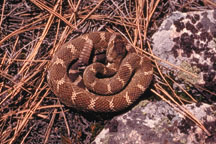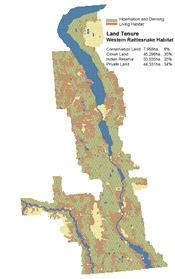|
Habitat Atlas for Wildlife at Risk
Western Rattlesnake
Crotalus viridis oreganus

Western
Rattlesnake
|

- Other Name: Northern Pacific Rattlesnake
- Length : adults 60 - 150 cm.
- Rattle at end of tail produces buzzing sound to
warn off intruders.
- Dark blotches banded with light-coloured edges
along center of back; dark stripe below eye to corner
of
jaw.
Status:
British Columbia Blue List
Special Significance
In British Columbia, the small population of Western
Rattlesnakes is restricted to the dry valleys of
the Southern Interior. Their exaggerated reputation
for danger has resulted in needless killing of rattlesnakes,
drastically reducing some local populations. Agricultural
development and urban expansion have also destroyed
rattlesnake dens and foraging areas.
Distribution
- Eight subspecies of the Western Rattlesnake are recognized, but
only C. viridis oreganus occurs in British Columbia at the northern
end
of its range, extending from California.
- British Columbia population is small and confined to
dry grasslands in Bunchgrass, Ponderosa Pine zones
of Okanagan-Similkameen, Thompson, Nicola and Kettle valleys, as
well as the Lytton-Lillooet
portion of the Fraser Canyon.
Habitat
- Found in rocky terrain or talus areas in forest or grassland habitats
- Migration takes place in spring to favorite foraging
and basking areas up to 1 km from den.
- In summer, rattlesnakes are found in open grassland
and areas with high rodent densities. They bask
on sunny, rocky ledges with scattered shrubs for shade.
- Snakes hibernate from September to April, returning
to the same communal den each year (which may be
shared with other species).
- Hibernating dens are in rock fissures or caves; located
on south facing rocky slopes or ridges at elevations
of 500 to 625m.
Reproduction
- Mating occurs in late summer; females store sperm over winter
with ovulation and fertilization occurring the following spring.
- Pregnant females stop feeding and stay close to the
den during summer as embryos develop; 13 to 14
months after mating, 2-8 young are born live in mid-September to
early October.
- Immediately after birth, the emaciated females enter
hibernation; while the newborns stay near the den
for 2 weeks, shed their skins, then also enter the den to hibernate.
- Females undergo a total fasting period of 19 months
or more during pregnancy and hibernation; reproduction
takes place every 3 years on average, since females need to double
body weight
before breeding again.
- Delayed reproduction commonly occurs because of long
hibernation period and limited energy stores; reproduction
often begins when female rattlesnakes are 7-9 years old.
- A rattlesnake's maximum known lifespan is 25 years.
Food Habits
- Adults eat mainly voles and mice, ground-nesting birds, pocket
gophers, wood rats, squirrels, chipmunks, muskrats, ground squirrels,
young
marmots, and young rabbits; young eat mainly newborn
voles and shrews.
- Foraging occurs from dusk to dawn.
- A snake's body coils and strikes forward when attacking
prey; one-half of body length is the normal striking
distance.
- Prey are stabbed and injected with venom from hollow
fangs; venom glands are located behind and below
each eye on upper jaw.
- Venom is chemically complex, but primarily acts to
break down proteins (e.g. blood vessel walls);
also affects nervous system.
Encounters
- Rattlesnake bites are very uncommon and very rarely fatal, although
they could be dangerous to young children.
- Snakes will only become aggressive if chased or cornered;
they are shy creatures which normally seek cover
when approached, and usually give people a warning rattle.
- Some rattlesnakes do not have rattles, including young
snakes and those which have been damaged by vehicles.
- If you see or hear a rattlesnake, freeze, then move
away, giving the snake a wide berth.
- If you feel a snake is a threat, it is much safer to
carefully capture a rattlesnake in a garbage can
than to try to kill it. Release the snake as soon as possible above
the capture location,
to ensure they are able to return to their den
site.
- Rattlesnakes are protected from killing or capture
under the British Columbia Wildlife Act.
Threats
- Their low reproductive rate means a slow recovery
rate after disturbances; small populations
are especially vulnerable.
- Extensive land development in the Okanagan has
eliminated or fragmented their habitat (including
dens and feeding grounds).
- Many rattlesnakes are intentionally killed by humans
as well as being killed on roadways
- Overgrazing by livestock has reduced their population
by limiting prey and cover.
Management Considerations
- Leave 1 km buffer zone around known den sites
and critical habitats.
- Avoid road and skid trail construction near
potential den sites such as rock outcroppings
and talus
slopes, and around known snake dispersal
routes.
- Avoid disturbing rock and woody debris in potential
snake habitat.
- Maintain good range condition in grasslands
for cover and prey species.
- Contact your local British Columbia Ministry
of Water, Land and Air Protection if
a den site is located.
|
References
1. Blood, D.A. 1993. Western Rattlesnake; Wildlife at Risk in British
Columbia. Brochure. Ministry of Water, Land and Air Protection. Victoria,
British Columbia.
2. Gregory, P.T. and R.W. Campbell. 1984. The reptiles
of British Columbia. British Columbia Provincial Museum Handbook No.
44. Victoria, BC.
3. Orchard, S.A. 1984. Amphibians and Reptiles of British
Columbia; an Ecological Review. Ministry of Forests. Victoria, British
Columbia.
|